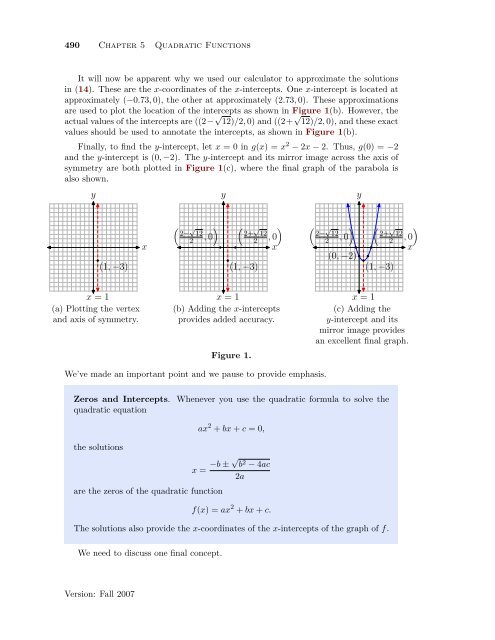5.4 The Quadratic Formula - College of the Redwoods
5.4 The Quadratic Formula - College of the Redwoods
5.4 The Quadratic Formula - College of the Redwoods
Create successful ePaper yourself
Turn your PDF publications into a flip-book with our unique Google optimized e-Paper software.
490 Chapter 5 <strong>Quadratic</strong> Functions<br />
It will now be apparent why we used our calculator to approximate <strong>the</strong> solutions<br />
in (14). <strong>The</strong>se are <strong>the</strong> x-coordinates <strong>of</strong> <strong>the</strong> x-intercepts. One x-intercept is located at<br />
approximately (−0.73, 0), <strong>the</strong> o<strong>the</strong>r at approximately (2.73, 0). <strong>The</strong>se approximations<br />
are used to plot <strong>the</strong> location <strong>of</strong> <strong>the</strong> intercepts as shown in Figure 1(b). However, <strong>the</strong><br />
actual values <strong>of</strong> <strong>the</strong> intercepts are ((2− √ 12)/2, 0) and ((2+ √ 12)/2, 0), and <strong>the</strong>se exact<br />
values should be used to annotate <strong>the</strong> intercepts, as shown in Figure 1(b).<br />
Finally, to find <strong>the</strong> y-intercept, let x = 0 in g(x) = x 2 − 2x − 2. Thus, g(0) = −2<br />
and <strong>the</strong> y-intercept is (0, −2). <strong>The</strong> y-intercept and its mirror image across <strong>the</strong> axis <strong>of</strong><br />
symmetry are both plotted in Figure 1(c), where <strong>the</strong> final graph <strong>of</strong> <strong>the</strong> parabola is<br />
also shown.<br />
y<br />
y<br />
y<br />
(1, −3)<br />
x<br />
( √ ) ( √ )<br />
2− 12<br />
2<br />
, 0 2+ 12<br />
2<br />
, 0<br />
x<br />
(1, −3)<br />
( √ ) ( √ )<br />
2− 12<br />
2<br />
, 0 2+ 12<br />
2<br />
, 0<br />
x<br />
(0, −2)<br />
(1, −3)<br />
x = 1<br />
(a) Plotting <strong>the</strong> vertex<br />
and axis <strong>of</strong> symmetry.<br />
x = 1<br />
(b) Adding <strong>the</strong> x-intercepts<br />
provides added accuracy.<br />
x = 1<br />
(c) Adding <strong>the</strong><br />
y-intercept and its<br />
mirror image provides<br />
an excellent final graph.<br />
Figure 1.<br />
We’ve made an important point and we pause to provide emphasis.<br />
Zeros and Intercepts. Whenever you use <strong>the</strong> quadratic formula to solve <strong>the</strong><br />
quadratic equation<br />
<strong>the</strong> solutions<br />
are <strong>the</strong> zeros <strong>of</strong> <strong>the</strong> quadratic function<br />
ax 2 + bx + c = 0,<br />
x = −b ± √ b 2 − 4ac<br />
2a<br />
f(x) = ax 2 + bx + c.<br />
<strong>The</strong> solutions also provide <strong>the</strong> x-coordinates <strong>of</strong> <strong>the</strong> x-intercepts <strong>of</strong> <strong>the</strong> graph <strong>of</strong> f.<br />
We need to discuss one final concept.<br />
Version: Fall 2007

















